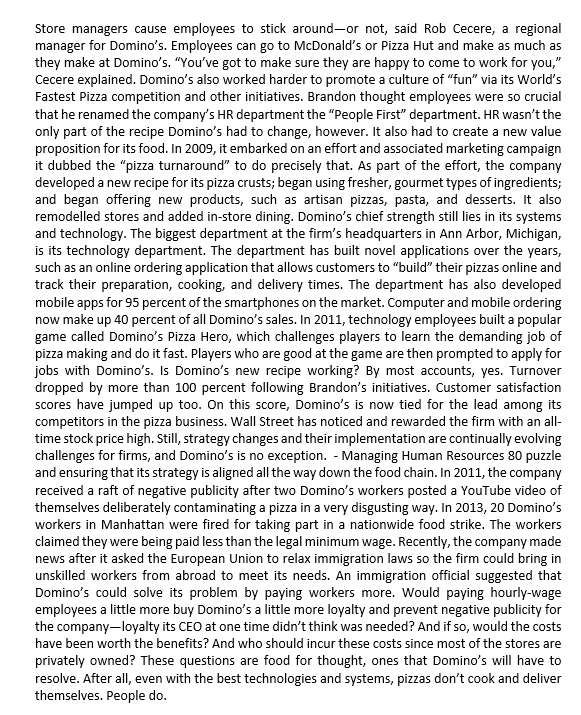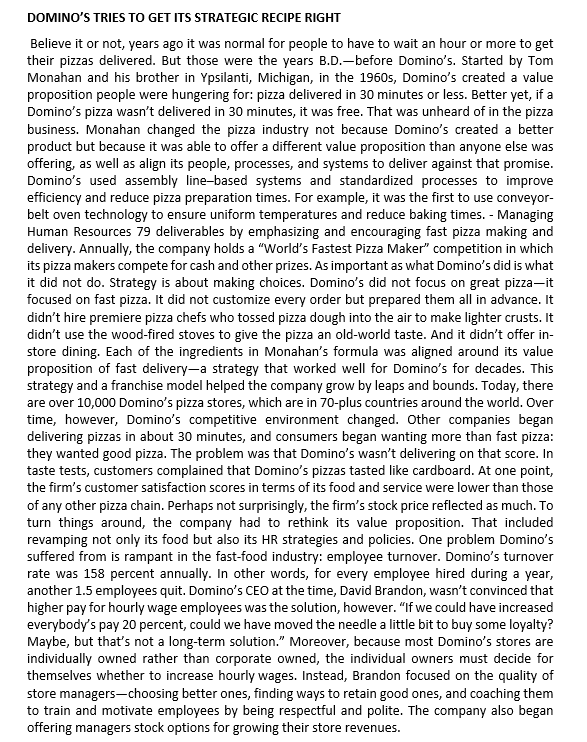Question: Based on your opinion, explain how Domino’s strategy differed from its competitors.
Question: Based on your opinion, explain how Domino’s strategy differed from its competitors.
Chapter1: An Overview Of Strategic Marketing
Section1.2: Dollar Shave Club: The Company For Men
Problem 2C
Related questions
Question
Question: Based on your opinion, explain how Domino’s strategy differed from its competitors.

Transcribed Image Text:Store managers cause employees to stick around-or not, said Rob Cecere, a regional
manager for Domino's. Employees can go to McDonald's or Pizza Hut and make as much as
they make at Domino's. "You've got to make sure they are happy to come to work for you,"
Cecere explained. Domino's also worked harder to promote a culture of "fun" via its World's
Fastest Pizza competition and other initiatives. Brandon thought employees were so crucial
that he renamed the company's HR department the "People First" department. HR wasn't the
only part of the recipe Domino's had to change, however. It also had to create a new value
proposition for its food. In 2009, it embarked on an effort and associated marketing campaign
it dubbed the "pizza turnaround" to do precisely that. As part of the effort, the company
developed a new recipe for its pizza crusts; began using fresher, gourmet types of ingredients;
and began offering new products, such as artisan pizzas, pasta, and desserts. It also
remodelled stores and added in-store dining. Domino's chief strength still lies in its systems
and technology. The biggest department at the firm's headquarters in Ann Arbor, Michigan,
is its technology department. The department has built novel applications over the years,
such as an online ordering application that allows customers to "build" their pizzas online and
track their preparation, cooking, and delivery times. The department has also developed
mobile apps for 95 percent of the smartphones on the market. Computer and mobile ordering
now make up 40 percent of all Domino's sales. In 2011, technology employees built a popular
game called Domino's Pizza Hero, which challenges players to learn the demanding job of
pizza making and do it fast. Players who are good at the game are then prompted to apply for
jobs with Domino's. Is Domino's new recipe working? By most accounts, yes. Turnover
dropped by more than 100 percent following Brandon's initiatives. Customer satisfaction
scores have jumped up too. On this score, Domino's is now tied for the lead among its
competitors in the pizza business. Wall Street has noticed and rewarded the firm with an all-
time stock price high. Still, strategy changes and their implementation are continually evolving
challenges for firms, and Domino's is no exception. - Managing Human Resources 80 puzzle
and ensuring that its strategy is aligned all the way down the food chain. In 2011, the company
received a raft of negative publicity after two Domino's workers posted a YouTube video of
themselves deliberately contaminating a pizza in a very disgusting way. In 2013, 20 Domino's
workers in Manhattan were fired for taking part in a nationwide food strike. The workers
claimed they were being paid less than the legal minimum wage. Recently, the company made
news after it asked the European Union to relax immigration laws so the firm could bring in
unskilled workers from abroad to meet its needs. An immigration official suggested that
Domino's could solve its problem by paying workers more. Would paying hourly-wage
employees a little more buy Domino's a little more loyalty and prevent negative publicity for
the company-loyalty its CEO at one time didn't think was needed? And if so, would the costs
have been worth the benefits? And who should incur these costs since most of the stores are
privately owned? These questions are food for thought, ones that Domino's will have to
resolve. After all, even with the best technologies and systems, pizzas don't cook and deliver
themselves. People do.

Transcribed Image Text:DOMINO'S TRIES TO GET ITS STRATEGIC RECIPE RIGHT
Believe it or not, years ago it was normal for people to have to wait an hour or more to get
their pizzas delivered. But those were the years B.D.-before Domino's. Started by Tom
Monahan and his brother in Ypsilanti, Michigan, in the 1960s, Domino's created a value
proposition people were hungering for: pizza delivered in 30 minutes or less. Better yet, if a
Domino's pizza wasn't delivered in 30 minutes, it was free. That was unheard of in the pizza
business. Monahan changed the pizza industry not because Domino's created a better
product but because it was able to offer a different value proposition than anyone else was
offering, as well as align its people, processes, and systems to deliver against that promise.
Domino's used assembly line-based systems and standardized processes to improve
efficiency and reduce pizza preparation times. For example, it was the first to use conveyor-
belt oven technology to ensure uniform temperatures and reduce baking times. - Managing
Human Resources 79 deliverables by emphasizing and encouraging fast pizza making and
delivery. Annually, the company holds a "World's Fastest Pizza Maker" competition in which
its pizza makers compete for cash and other prizes. As important as what Domino's did is what
it did not do. Strategy is about making choices. Domino's did not focus on great pizza-it
focused on fast pizza. It did not customize every order but prepared them all in advance. It
didn't hire premiere pizza chefs who tossed pizza dough into the air to make lighter crusts. It
didn't use the wood-fired stoves to give the pizza an old-world taste. And it didn't offer in-
store dining. Each of the ingredients in Monahan's formula was aligned around its value
proposition of fast delivery-a strategy that worked well for Domino's for decades. This
strategy and a franchise model helped the company grow by leaps and bounds. Today, there
are over 10,000 Domino's pizza stores, which are in 70-plus countries around the world. Over
time, however, Domino's competitive environment changed. Other companies began
delivering pizzas in about 30 minutes, and consumers began wanting more than fast pizza:
they wanted good pizza. The problem was that Domino's wasn't delivering on that score. In
taste tests, customers complained that Domino's pizzas tasted like cardboard. At one point,
the firm's customer satisfaction scores in terms of its food and service were lower than those
of any other pizza chain. Perhaps not surprisingly, the firm's stock price reflected as much. To
turn things around, the company had to rethink its value proposition. That included
revamping not only its food but also its HR strategies and policies. One problem Domino's
suffered from is rampant in the fast-food industry: employee turnover. Domino's turnover
rate was 158 percent annually. In other words, for every employee hired during a year,
another 1.5 employees quit. Domino's CEO at the time, David Brandon, wasn't convinced that
higher pay for hourly wage employees was the solution, however. "If we could have increased
everybody's pay 20 percent, could we have moved the needle a little bit to buy some loyalty?
Maybe, but that's not a long-term solution." Moreover, because most Domino's stores are
individually owned rather than corporate owned, the individual owners must decide for
themselves whether to increase hourly wages. Instead, Brandon focused on the quality of
store managers-choosing better ones, finding ways to retain good ones, and coaching them
to train and motivate employees by being respectful and polite. The company also began
offering managers stock options for growing their store revenues.
Expert Solution
This question has been solved!
Explore an expertly crafted, step-by-step solution for a thorough understanding of key concepts.
This is a popular solution!
Trending now
This is a popular solution!
Step by step
Solved in 2 steps

Recommended textbooks for you

